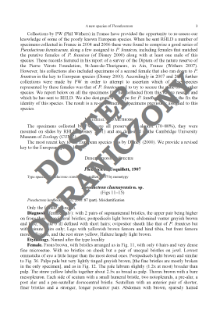- Search in all Repository
- Literature and maps
- Archeology
- Mills database
- Natural sciences
Advanced search
Advanced search
Advanced search
Advanced search
Advanced search

Object
Title: A synopsis of the milliped genus Brachycybe Wood, 1864 (Platydesmida: Andrognathidae)
Creator:
Shelley, Rowland M. ; McAllister, Chris T. ; Tanabe, Tsutomu (1962– ) ; Polska Akademia Nauk. Muzeum i Instytut Zoologii
Date issued/created:
Resource type:
Subtitle:
Fragmenta Faunistica, vol. 48, no. 2 ; Rewizja rodzaju Brachycybe Wood, 1864 krocionogów (Platydesmida: Andrognathidae)
Publisher:
Museum and Institute of Zoology, PAS
Place of publishing:
Description:
Bibliogr. p. 162-165 ; P. 137-166 : ill. ; 25 cm ; Abstarct in Polish. Taxa in Latin.
Type of object:
Abstract:
The milliped genus Brachycybe Wood, 1864 (Platydesmida: Andrognathidae) comprises seven species in the eastern and western United States (two and three species, respectively) and Japan/South Korea and China (onespecies each); it is provisionally assigned to a broad-bodied platydesmid in Taiwan that may constitute an eighthspecies. Brachycybe is characterized by long, alate paranota, distinct dorsal tubercles, and closely proximate opposing legs that are separated by an anteriorly directed process. Species are identified by somatic features like the configurations of the colla, the presence or absence of notches on the caudal paranotal margins, the relative sizes of the tubercles and lengths of the rows, and the relative lengths of the legs; a key and anatomical illustrations facilitate determinations. Distributions are characterized by allopatric populations indicative of age; extreme disjunctions exist in B. lecontii Wood, 1864, and B. producta Loomis, 1936, in the eastern and western US, respectively. The former is projected for the southeastern corner of Kansas and is newly documented from Missouri and Texas; the latter is newlyrecorded from Oregon. Sinocybe Loomis, 1942, is placed in synonymy under Brachycybe, and S. cooki Loomis, 1942,is transferred into the genus; the synonymy of Platydesmus californicus Karsch, 1881, under B. rosea Murray, 1877, is confirmed.
Relation:
Volume:
Issue:
Start page:
End page:
Detailed Resource Type:
Format:
Resource Identifier:
oai:rcin.org.pl:54190 ; 10.3161/00159301FF2005.48.2.137
Source:
MiIZ PAN, call no. P.256, T. 48 nr 2 ; MiIZ PAN, call no. P.4664, T. 48 nr 2 ; click here to follow the link
Language:
Rights:
Rights Reserved - Restricted Access
Terms of use:
Digitizing institution:
Museum and Institute of Zoology of the Polish Academy of Sciences
Original in:
Library of the Museum and Institute of Zoology of the Polish Academy of Sciences
Projects co-financed by:
Programme Innovative Economy, 2010-2014, Priority Axis 2. R&D infrastructure ; European Union. European Regional Development Fund
Access:
Object collections:
- Digital Repository of Scientific Institutes > Partners' collections > Museum and Institute of Zoology PAS > Scientific Journals
- Digital Repository of Scientific Institutes > Partners' collections > Museum and Institute of Zoology PAS > MIZ PAN Publications > Fragmenta Faunistica
- Digital Repository of Scientific Institutes > Literature > Journals/Articles
Last modified:
Aug 2, 2024
In our library since:
Jun 8, 2015
Number of object content downloads / hits:
80
All available object's versions:
https://rcin.org.pl./publication/61186
Show description in RDF format:
Show description in RDFa format:
Show description in OAI-PMH format:
Objects Similar
Huth, Angela Polska Akademia Nauk. Muzeum i Instytut Zoologii International Congress of Myriapodology (11 ; 1999 ; Białowieża)
Kobahidze, David Nestorovič (1911–1970)
Golovač, Sergej Il'ič (1952– ) Hoffman, Richard Lawrence (1927–2012) Polska Akademia Nauk. Muzeum i Instytut Zoologii International Congress of Myriapodology (11 ; 1999 ; Białowieża)
Dziadosz, Cezary
Golovač, Sergej Il'ič (1952– ) Adis, Joachim (1950–2007) Polska Akademia Nauk. Muzeum i Instytut Zoologii
Kime, Richard Desmond (1932– ) Polska Akademia Nauk. Muzeum i Instytut Zoologii International Congress of Myriapodology (11 ; 1999 ; Białowieża)
Dziadosz, Cezary
Enghoff, Henrik Polska Akademia Nauk. Muzeum i Instytut Zoologii International Congress of Myriapodology (11 ; 1999 ; Białowieża)

 INSTYTUT ARCHEOLOGII I ETNOLOGII POLSKIEJ AKADEMII NAUK
INSTYTUT ARCHEOLOGII I ETNOLOGII POLSKIEJ AKADEMII NAUK
 INSTYTUT BADAŃ LITERACKICH POLSKIEJ AKADEMII NAUK
INSTYTUT BADAŃ LITERACKICH POLSKIEJ AKADEMII NAUK
 INSTYTUT BADAWCZY LEŚNICTWA
INSTYTUT BADAWCZY LEŚNICTWA
 INSTYTUT BIOLOGII DOŚWIADCZALNEJ IM. MARCELEGO NENCKIEGO POLSKIEJ AKADEMII NAUK
INSTYTUT BIOLOGII DOŚWIADCZALNEJ IM. MARCELEGO NENCKIEGO POLSKIEJ AKADEMII NAUK
 INSTYTUT BIOLOGII SSAKÓW POLSKIEJ AKADEMII NAUK
INSTYTUT BIOLOGII SSAKÓW POLSKIEJ AKADEMII NAUK
 INSTYTUT CHEMII FIZYCZNEJ PAN
INSTYTUT CHEMII FIZYCZNEJ PAN
 INSTYTUT CHEMII ORGANICZNEJ PAN
INSTYTUT CHEMII ORGANICZNEJ PAN
 INSTYTUT FILOZOFII I SOCJOLOGII PAN
INSTYTUT FILOZOFII I SOCJOLOGII PAN
 INSTYTUT GEOGRAFII I PRZESTRZENNEGO ZAGOSPODAROWANIA PAN
INSTYTUT GEOGRAFII I PRZESTRZENNEGO ZAGOSPODAROWANIA PAN
 INSTYTUT HISTORII im. TADEUSZA MANTEUFFLA POLSKIEJ AKADEMII NAUK
INSTYTUT HISTORII im. TADEUSZA MANTEUFFLA POLSKIEJ AKADEMII NAUK
 INSTYTUT JĘZYKA POLSKIEGO POLSKIEJ AKADEMII NAUK
INSTYTUT JĘZYKA POLSKIEGO POLSKIEJ AKADEMII NAUK
 INSTYTUT MATEMATYCZNY PAN
INSTYTUT MATEMATYCZNY PAN
 INSTYTUT MEDYCYNY DOŚWIADCZALNEJ I KLINICZNEJ IM.MIROSŁAWA MOSSAKOWSKIEGO POLSKIEJ AKADEMII NAUK
INSTYTUT MEDYCYNY DOŚWIADCZALNEJ I KLINICZNEJ IM.MIROSŁAWA MOSSAKOWSKIEGO POLSKIEJ AKADEMII NAUK
 INSTYTUT PODSTAWOWYCH PROBLEMÓW TECHNIKI PAN
INSTYTUT PODSTAWOWYCH PROBLEMÓW TECHNIKI PAN
 INSTYTUT SLAWISTYKI PAN
INSTYTUT SLAWISTYKI PAN
 SIEĆ BADAWCZA ŁUKASIEWICZ - INSTYTUT TECHNOLOGII MATERIAŁÓW ELEKTRONICZNYCH
SIEĆ BADAWCZA ŁUKASIEWICZ - INSTYTUT TECHNOLOGII MATERIAŁÓW ELEKTRONICZNYCH
 MUZEUM I INSTYTUT ZOOLOGII POLSKIEJ AKADEMII NAUK
MUZEUM I INSTYTUT ZOOLOGII POLSKIEJ AKADEMII NAUK
 INSTYTUT BADAŃ SYSTEMOWYCH PAN
INSTYTUT BADAŃ SYSTEMOWYCH PAN
 INSTYTUT BOTANIKI IM. WŁADYSŁAWA SZAFERA POLSKIEJ AKADEMII NAUK
INSTYTUT BOTANIKI IM. WŁADYSŁAWA SZAFERA POLSKIEJ AKADEMII NAUK


































